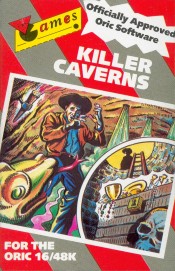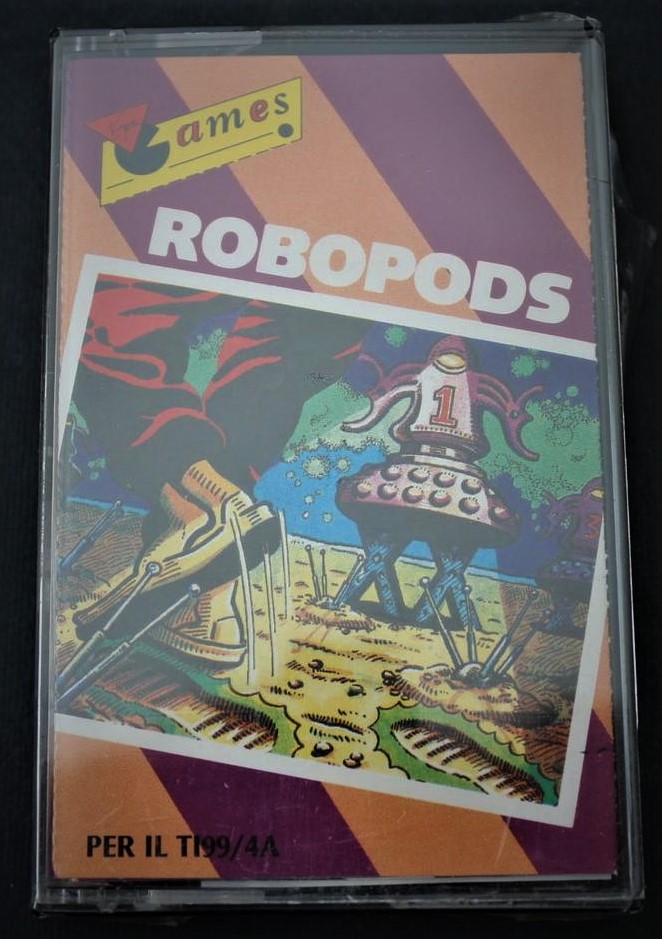The first Virgin Game: Yomp (1983)
Welcome.
My name is Adam and welcome to “The Retro Bloginator”.
This first blog is about Virgin Games’ “Yomp”, released in 1983 for the Spectrum 16K and 48K.
This is one of Virgin Games first releases as indicated by the catalogue number VGA 1001 on the spine.
The other games released at the same time were VGA 1002 “Starfire”, VGA 1003 “Sheepwalk” and VGA 1004 “Golf”, all for the Spectrum.
The inlay is very typical of Virgin Games’ early releases. The bi-colour diagonal stripes featured on all releases, with the blue and pink stripes indicating it was software for the Spectrum.
Here are examples of games for other computers:
Bug Bomb for the BBC B (VGA 2001)
Mission Mercury for the VIC 20 (VGA 3001)
Falcon Patrol for the Commodore 64 (VGB 6001)
Robopods for the TI99/4A (VGB 7001)
The description on the rear reads:
YOMP: COMMAND THE PARAS AND TAKE ON THE IMPOSSIBLE by Terry Murray and Roy Poole. We’ll learn a little more about the programmers later.
So, I’ve established that the game is about paratroopers, a truck and a minefield, but what is a “Yomp”?
It’s a British slang word meaning “to march with heavy equipment over difficult terrain”.
The Falklands War between Argentina and the United Kingdom happened in 1982, so it appears “Yomp” is an homage to the British paratroopers who served in this conflict.
Opening up the inlay shows a screenshot of men at the bottom of the screen, with vehicles on a road above them. The terms “Men Left” and “Men Across” indicate you need to get the men across the road, dodging the traffic.
The description reads:
Any time, any place, the paras are ready for action! Dropped behind enemy lines, you must take command of F Platoon and yomp your men across dangerous enemy highways and a closely guarded minefield to reach your objective and succeed in this top secret mission.
Determine just how tough your mission will be by selecting your rank from private to colonel, then start to guide your men, one by one, across the enemy highways - dodging the fast-moving enemy jeeps and troop vehicles. There’s no turning back now!
When three men are safely across, activate your radar scanner to direct them across the enemy minefield. Beware, an armed sentry is on patrol! Guide them carefully across the deadly terrain, but watch out, for the enemy has placed ‘movement sensors’ in the minefield, and if you bump into the trees or fence too often the mines may be triggered! If you successfully get your unit across, you are allocated three more paras to re-inforce your platoon.
The going gets tough, but you can’t afford to lose your head now. The success of the mission depends on you!
The instructions are pretty basic. Keyboard only control using the 1 key to move left, the 2 key to move right and the 0 key to move up.
A unique feature about early Virgin Games releases is that Richard Branson, the owner of the Virgin Group, wanted the developers to be treated like “Rock Stars”, just as many of the artists at his hugely successful Virgin Records label were. This meant that all the developers got a small biography on the inlay.
Terry Murray was born in 1951 and educated at Manchester University. He is married with three children and has worked for the Post Office for 12 years. Terry has 5 years’ experience in high level language programming in Pascal, Cobol and Fortran.
His view is that the use of computers to play games is a pleasurable way to introducing computers in the home. His interests include TV and indoor hang-gliding.
Contribution to ‘Yomp’ - to ensure that the graphics bear some resemblance to reality.
Roy Poole is 29, was born in Lincolnshire and educated in Liverpool. He has worked for the Post Office for 10 years and has a special interest in electronics. Roy has been programming in assembly language since he built his first computer in 1979 (a Nascom kit) and admits to getting more satisfaction from writing games than playing them.
His interests include squash, running and swimming.
Contribution to ‘Yomp’ - many late nights programming to ensure maximum enjoyment of the game.
It seems strange that a published game would be written by two people nowadays, but this was common in the 80’s with microcomputers.
I don’t think Terry and Roy quite hit the heights of “Rock Star” status, but it’s still nice to see their faces and know a little bit about the developers.
Terry and Roy wrote 4 more games together. Rider and Space Command in 1984 for Virgin Games, Rainy Day also in 1984 for CCS (Cases Computer Simulations) and Desert Burner in 1985 for Sparklers.
Rider for the Spectrum 48K (VGC 1014)
Space Command for the Spectrum 48K (VGC 1018)
Rainy Day for the Spectrum 48K
Desert Burner for the Spectrum 48K
There’s also a form on the inlay that can be torn off and completed. If you posted the form to the address provided in London, you got one year’s free membership to the “Virgin Games Gang”! Effectively 1983’s version of an e-mail subscription, “Gang Members” got advance information on upcoming programs, various special offers and an entry into the “Virgin Games Draw”.
First prize was £500 worth of hardware and software of your choice. Not bad for 1983!
There were 5 second prizes of £100 worth of software, 50 third prizes of a Virgin Games T-Shirt and 100 fourth prizes of a special Virgin Games Poster. I wonder if any of the winners still have their prizes? I must admit, I wouldn’t mind one of the t-shirts.
I like some of the questions on the form too. Try them and get your hit of nostalgia:
Where did you buy this cassette?
When did you first buy a computer?
How long have you had your present computer?
Talking about cassettes, I was a little surprised that it was a snapped together shell and not a screwed together shell seeing it was from Virgin (you’d assume they’d have used the same factory as Virgin Records for the cassettes). It felt quite cheap.
However, the label on side A is pretty cool, with red and black diagonal stripes. The load command of LOAD “” is shown on the left-hand side.
On the right-hand side though, it says “Now listen to the other side”. What could it be? A message from the developers? Music? I remember having the odd tape for my Commodore 64 with music on side B (Platoon comes to mind), but they’d normally tell you on the inlay or the cassette what the song was, which wasn’t the case here.
Playing side B, I was introduced to a typical early 80’s synth track. I’d never heard it before so immediately asked Siri on my iPhone to identify it. “Glory” by Steve Hillage. Bit of a strange song, but I enjoyed it. The link to listen to the full version on Spotify is below (there was an abridged 3-minute version on the cassette):
This then got me thinking about the song. Why was it on there? I already had a clue thanks to Siri. Had I bought this game in 1983 I would have been clueless. I would have had to join “The Gang” and ask Virgin Games by sending a letter and asking them directly.
I found the song on Google, and it was from Steve Hillage’s 1982 album “For To Next”, released by Virgin Records. That at least explains the Virgin link. It also came with a bonus album “And Not Or”. Strange titles for albums, but then it starts to make sense.
FOR
TO
NEXT
AND
NOT
OR
These are all BASIC commands for writing computer programs.
A nice tie in. Virgin Games’ first computer game gets music from an album inspired by computer programming.
However, still a strange thing to do in 1983. If it was a way of promoting album sales, you’d probably think that they’d give you the song and the artist's name somewhere.
I also got around to looking at some reviews in computer magazines from 1983.
The general consensus was that it was an average attempt at a “Frogger” clone. Also, that the price tag of £7.95 was a bit on the expensive side for pretty average game.
My thoughts are that this game is extremely difficult. It’s sometimes hard to gauge where your hit box starts. You think you’re in between the traffic and safe. Then a truck comes along, and you die.
Also, there’s only a forward key. You commit to a gap between the traffic but then you realise it wasn’t such a good idea. But instead of retreating, you either have to wait for a truck to mow you down or you commit suicide by jumping into the side of one.
I never actually got to the second level with the minefield, so I can’t pass judgment on that.
Graphics and sound are pretty much what you would expect for a 16K Spectrum programme from 1983, but at least there’s a bit of colour to keep things pleasing on the eye.
I’d give this game a steady 5 out of 10. Considering it was programmed by two post office workers who presumably managed to sell their program to Virgin Games to publish (the loading screen shows Oz Software as do other games written by Murray and Poole), it’s a pretty decent effort. If it were a little easier it might have even pushed to a 6. Maybe even a 7 if the mine level was any good.
Thanks for reading my first blog. They’ll be more obscure retro randomness in the next one.
Update: I managed to get 3 paras across the road! The minefield level is actually pretty good. You have a guard patrolling the minefield and a radar map showing you where the mines are. I managed to get 2 across the minefield and they were awarded the VC (Victoria Cross). The 3rd didn’t make it though. Lest we forget…




.jpg)















:format(jpeg):mode_rgb():quality(90)/discogs-images/R-1419912-1218188707.jpeg.jpg)
:format(jpeg):mode_rgb():quality(90)/discogs-images/R-1345686-1281241401.jpeg.jpg)




Comments
Post a Comment